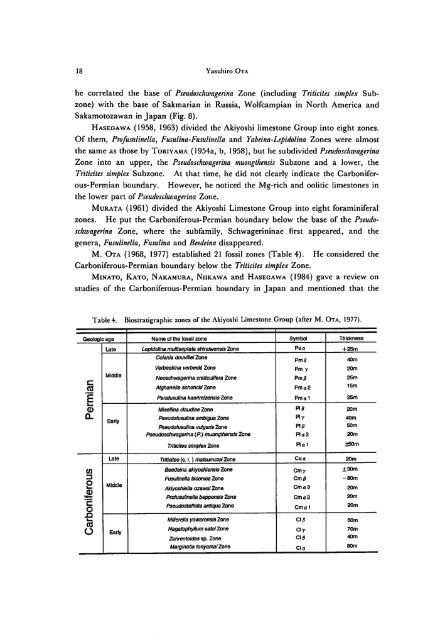Biostratigraphy of the Akiyoshi Limestone Group,
Biostratigraphy of the Akiyoshi Limestone Group,
Biostratigraphy of the Akiyoshi Limestone Group,
Create successful ePaper yourself
Turn your PDF publications into a flip-book with our unique Google optimized e-Paper software.
18 Yasuhiro Ota<br />
he correlated <strong>the</strong> base <strong>of</strong> Pseudoschwagerina Zone (including Triticites simplex Subzone)<br />
with <strong>the</strong> base <strong>of</strong> Sakmarian in Russia, Wolfcampian in North America and<br />
Sakamotozawan in Japan (Fig. 8).<br />
Hasegawa (1958, 1963) divided <strong>the</strong> <strong>Akiyoshi</strong> limestone <strong>Group</strong> into eight zones.<br />
Of <strong>the</strong>m, Pr<strong>of</strong>usulinella, Fusulina-Fusulinella and Yabeina-Lepidolina Zones were almost<br />
<strong>the</strong> same as those by Toriyama (1954a, b, 1958), but he subdivided Pseudoschwagerina<br />
Zone into an upper, <strong>the</strong> Pseudoschwagerina muong<strong>the</strong>nsis Subzone and a lower, <strong>the</strong><br />
Triticites simplex Subzone. At that time, he did not clearly indicate <strong>the</strong> Carbonifer<br />
ous-Permian boundary. However, he noticed <strong>the</strong> Mg-rich and oolitic limestones in<br />
<strong>the</strong> lower part <strong>of</strong> Pseudoschwagerina Zone.<br />
Murata (1961) divided <strong>the</strong> <strong>Akiyoshi</strong> <strong>Limestone</strong> <strong>Group</strong> into eight foraminiferal<br />
zones. He put <strong>the</strong> Carboniferous-Permian boundary below <strong>the</strong> base <strong>of</strong> <strong>the</strong> Pseudo<br />
schwagerina Zone, where <strong>the</strong> subfamily, Schwagerininae first appeared, and <strong>the</strong><br />
genera, Fusulinella, Fusulina and Beedeina disappeared.<br />
M. Ota (1968, 1977) established 21 fossil zones (Table 4). He considered <strong>the</strong><br />
Carboniferous-Permian boundary below <strong>the</strong> Triticites simplex Zone.<br />
Minato, Kato, Nakamura, Niikawa and Hasegawa (1984) gave a review on<br />
studies <strong>of</strong> <strong>the</strong> Carboniferous-Permian boundary in Japan and mentioned that <strong>the</strong><br />
Table 4. Biostratigraphic zones <strong>of</strong> <strong>the</strong> <strong>Akiyoshi</strong> <strong>Limestone</strong> <strong>Group</strong> (after M. Ota, 1977).<br />
Geologic age Name <strong>of</strong><strong>the</strong> fossil zone Symbol Thickness<br />
C<br />
CO<br />
E<br />
Q_<br />
Late Lepldollna multiseptata shlraiwensis Zone Puo +25m<br />
Middle<br />
Early<br />
Colania douvillei Zone<br />
Verbeekina verbeekl Zone<br />
Neoschwagerina craticullfera Zone<br />
Afghanellaschenckl Zone<br />
Parafusulina kaerimlzensis Zone<br />
Misellina daudiae Zone<br />
Pseud<strong>of</strong>usulina ambigua Zone<br />
Pseud<strong>of</strong>usulina vulgaris Zone<br />
Pseudoschwagerina (P.) muong<strong>the</strong>nsis Zone<br />
Triticites simplex Zone<br />
PmS<br />
Pm y<br />
PmjS<br />
Pma2<br />
Pma1<br />
PIS<br />
Ply<br />
PI/5<br />
Pla2<br />
Plal<br />
40m<br />
20m<br />
25m<br />
15m<br />
25m<br />
20m<br />
40m<br />
50m<br />
20m<br />
±50m<br />
Late Triticites (s. 1.) matsumotoi Zone Cua 20m<br />
CO<br />
2<br />
*^<br />
'c<br />
o<br />
.a<br />
I—<br />
CO<br />
O<br />
Middle<br />
Early<br />
Beedeina akiyoshiensis Zone<br />
Fusulinella biconica Zone<br />
<strong>Akiyoshi</strong>ella ozawalZone<br />
Pr<strong>of</strong>usulinella beppensis Zone<br />
Pseudostaftella antiqua Zone<br />
Millerellayowarensts Zone<br />
Nagatophyllum satol Zone<br />
Zahrentoldes sp. Zone<br />
Marginalia toriyama! Zone<br />
Cmy<br />
Cm 3<br />
Cm a 3<br />
Cm a 2<br />
Cma1<br />
CIS<br />
Cly<br />
CI0<br />
CI a<br />
±30m<br />
-80m<br />
20m<br />
20m<br />
20m<br />
60m<br />
70m<br />
40m<br />
80m
















